Saturday, September 14thElliot was halfway between Darwin and Alice Spring. We began the day with a small walk in the village. The "star" of this morning was the White-plumed Honeyeater a common bird more in the south. The landscapes became more and more dry as we came down in the South. Not many cars but the famous "Road Train" which are not so easy to overtake! We made our first stop in one of the old telegraphic relays which follow the road. These stations were built at the end of the XIXè century during the implementation of the telegraph which connected the South of Australia with the rest of the world. Established approximately every 200 kilometres, they had allowed the maintenance of the line and for traveller who stopped overnight. Most of stations was destroy now and few was converted in museum. At the end of the morning we stopped in the very well known site of Devil Marble. It was a granitic chaos which was sacred for some aboriginal tribes. It was rather spectacular. Moreover, we saw our first Australian Magpie, Crested Pigeon and Spinifex Pigeon. For this last species, it's even the only sight we do. Other break along the road left us some very beautiful memories: our first couple of Variegated Fairywren quite close. The male of this species have a blue and black head of the most beautiful effect. Shortly before arriving at Alice Spring, we had the luck to see two Pink Cockatoo. This Cockatoo has magnificent pink nuance in all the plumage. We were at the limit of the distribution of this species according to the cards: it always a pleasure to see such a bird when it was not foreseen... Sunday, September 15thWe were settled in a big campsite near the town centre. Our first observations in city was interesting: Spiny-cheeked Honeyeater, Spotted Dove, and Port Lincoln Ringneck... We had meeting with Robert Read, a local ornithologist who suggested us to join him with a small group for a day trip in the South of Alice Spring. First, we went to Stuarts Well about 100 kilometers of Alice Spring. Then, we took a track eastward, not without having made a small stop to look for the Splendid Fairywren. After few minutes we saw a beautiful male distinguishes itself by its song: it began rather well! The day had passed quickly with numerous pauses to look for passerines in the bush: Red-capped Robin, Crested Bellbird, Australasian Pipit... Our companion even showed us a Grey Fantail which he had track down the site on GPS! Indeed, it was a rare species here. We also saw birds of prey, in particular the Australian Hobby and an adult Collared Sparrowhawk. This day was the warmest of the trip with 37°C in the shadow during the lunch. We ended it by observing the sunset on Alice Spring from Anzac Hill Monday, September 16thWe began our trip of 3 days in West MacDonnell Range. It was a small mountain range which extends on each side of Alice Spring. The part West is the most known. Few rivers crossed the Range and had dug spectacular gorge. The first one, Simpsons Gap is one of the sites where we saw the Black Rock Wallaby. It was a small Kangaroo which lived in rocky chaos during the day and which came down at night to feed. After a 2 minutes research we discovered the animalsin the shadow of the climb. I did not think that it would be so easy to find them. Afterward, we had other occasions to observe them often in better conditions than the first time. Birds was interesting too : Singing Honeyeater, Grey-headed Honeyeater, Grey Shrike-thrush. In the sky, a Peregrine Falcon made few going returns and I eventually he landed on his nest. At the same time, Little Woodswallow flew without caring about their powerful neighbours. The second site was a renowned place of bathing: Ellery Creek Big-Hole. Indeed, we found quite a lot of people there (everything is relative!). Nevertheless, birds are present in good number on the left part of the ponds : Grey Teal, Hardhead, Dusky Moorhen, Pink-eared Duck, Eurasian Coot, Australasian Grebe. I did not expect to find so many birds and so many species in a so small pond ( less than 200 metres in diameter) with the high level human pressure we noticed ! We decided to make a walk around. Unfortunatly, when we crossed the first hill we discovered that everything was burned... Nevertheless we continued with the intend to do a small loop. On this black ground , we eventually observed 3 Dusky Grasswren! We wandered trought the rest of the road quitly and we arrived in the evening at Glen Helen: it's a small lodge with campsite close to a cliff cut by a river : a very beautifull place in fact. Tuesday, September 17thThe night was very animated: just after the sunset, the wind got up with an impressive power. The tent was ok, but our space in it was reduced by a good third! In the morning, the wind was still strong and the temperature was the lower of our trip: only 10°C... After a good breakfast, we walked along the cliff. it's really magnificent. We found a colony of Black Rock Wallaby. A couple of Peregrine falcon offered us a beautiful and noisily spectacle. At this place, the arm of the river was still in water and we found some ducks, some Black Cormorants and a Great Crested Grebe. We also discovered some Black-fronted Dotterel for the first time. Then we took the car to go to the Redbank Gorge. For us, it was the most beautiful of all those we visited. It was also one of the most deeply embanked. If the water was not so cold I would like to see on the other side of the gorge! Black Rock Wallaby and Little Woodswallow was present here. Furthermore, we had the chance to see two White-backed Swallow and especially a small group of Painted Finch. They shortly stopped just in front of us for drinking before disappearing. We were very lucky to fall on it! On the return, we saw our first Hooded Robin. At any points of view this site was really wonderfull! After the lunch, we drove to Serpentine Gorge. It hasn't the charm of the previous one. A little farther, we visited, Ochre Pits. It was an aboriginal site containing ochre from yellow to red with all the intermediate nuances. They always used it today during ceremonies. We ended the day to Ormiston Gorge. This site was also very impressive with a big cliff in arc of a circle. We followed it during half an hours and we were rewarded by a magnificent panorama on neighborhood. Every hole of water was occupied by Gray Teals easy to approach. We pursued our walk up to the nightfall. At this time, Black Rock Wallaby came down in the valley. That allowed us to make very good sights without frightening... Wednesday, September 18thWe came back to Alice Spring by a track more in the South which allowed us not to return on our steps. The beginning of morning was interesting with quite a lot of birds in particular a small group of Budgerigar and some Mulga Parrot. We also saw our first ones Red Kangaroo before arriving at Tyler Pass. This point gave a beautiful panorama on Gosse Bluff still called Tnorala Conservation Reserve. It was the rest of the a comet's impact several million years ago which generated a crater of more than twenty kilometres in diameter. There's no trace of this crater today. What we saw today it was only the centre of the impact which was very impressive from Tyler Pass. It was a sacred site for the aborigines. Once inside, we meet little ourselves as in a mountainous zone. A little farther was the Finke Gorge NP renowned for the Palm Valley. This park was particularly dry. However, at the level of the reclaimed river we could found some palm trees (Livistona mariae). From our point of view, the place has not the wild beauty of the MacDonnell's gorges . Un peu plus loin se trouve le "Finke Gorge NP" réputé pour la "Palm Valley". Ce parc est particulièrement aride. Toutefois, au niveau de la rivière asséchée on trouve quelques palmiers (Livistona mariae). De notre point de vue, l'endroit n'a pas la beauté sauvage des gorges des MacDonnell. Jeudi 19 septembreWe decided to end our stay to Alice Spring by visiting Desert Park. This big domain allowed to discover easely the fauna and the flora of the area in very good conditions. Most of the birds were present in big aviaries. From an educational point of view it was very well made. Moreover, a big part of the reptiles and mammals of the region were visible. Wild birds were abundant in the park especially Variegated Fairywren ! We made our first observations of Grey-crowned Babbler and Western Bowerbird. At the beginning of afternoon we took a plane for Cairns. At the end of the evening we arrived at Cairns. The night will fall rather fast but we had the time to make two news notches, House sparrow and Common Myna : two imported species on this continent ! We settled down in a bungalow in a campsite close to the town centre. |
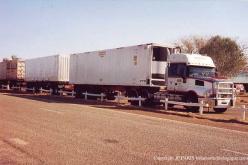 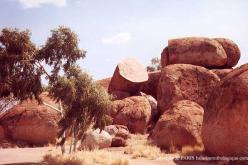 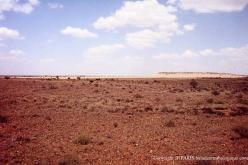 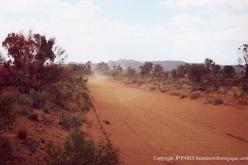   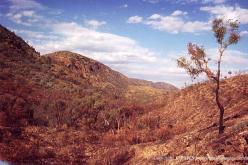 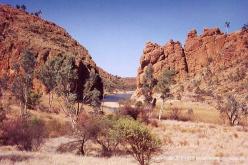 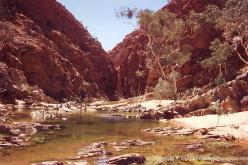  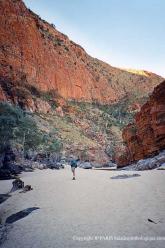 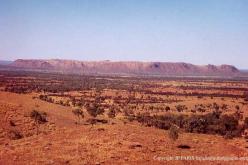 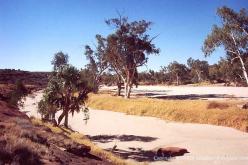 |